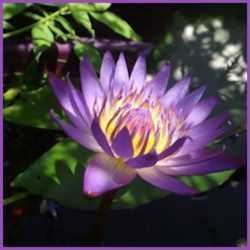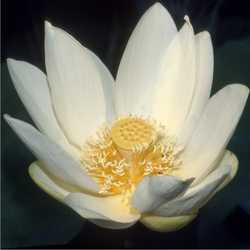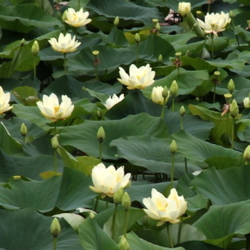These astonishingly beautiful flowers are also astonishingly easy to grow. Also known as "Sacred Water Lily," lotus (Nelumbo) hybrids come in a variety of white, yellow, and pink shades. True "bowl lotus" can be grown in containers as small as one or two gallons. Larger varieties will need larger containers, and a few big ones are really only suitable for pond plantings. It's easier to find a "big enough" container for lotus than for water lilies, since many lotus varieties are happy in very shallow water. With water lilies for container gardening, a large potted plant gets sunk in a container of water large enough to cover the planting pot by at least six inches. A lotus, on the other hand, may need only a couple inches of water above the soil level, so that means lots more room for soil and roots in a given container. 
Lotus tubers are only available seasonally, as they are nearly impossible to ship once they break dormancy in late spring. Now is a time for browsing online selections and looking for good sales on large no-hole containers. I like the double-wall plastic containers for their good looks and lightweight durability. If you change your mind about using the container for water gardening down the line, drill a few drainage holes through the bottom.
I found great prices and even better advice at a sale this year from Texas Water Lilies. Using their planting guidelines, I put a larger lotus (‘Pink Pretty Princess Payton') in a 22-inch container, and it turned into this enormous bloom machine! The compact variety (‘Chawan Basu') that I put into an 18-inch container has lots of  leaves but no blooms yet. Maybe it's waiting to bloom until after it has filled the container with roots. Next year, I will try some "bowl lotus" varieties in smaller two or three gallon containers and see what happens.
leaves but no blooms yet. Maybe it's waiting to bloom until after it has filled the container with roots. Next year, I will try some "bowl lotus" varieties in smaller two or three gallon containers and see what happens.
Hardiness can be tricky to estimate when plants are in containers rather than in the ground or in a pond. I decided to hedge my bet by digging my containers partway into the ground.  I dug my hole, placed my pot, leveled it, and continued to check the level while filling in around the edges with loose dirt. To check the level, put a straight board across the top of the pot, and use a carpenter's level on the board. If you don't have a level, use a glass of water on the board and eyeball it. Lean on the edge of the pot to adjust the level, then firm up the dirt around the sides of the pot.
I dug my hole, placed my pot, leveled it, and continued to check the level while filling in around the edges with loose dirt. To check the level, put a straight board across the top of the pot, and use a carpenter's level on the board. If you don't have a level, use a glass of water on the board and eyeball it. Lean on the edge of the pot to adjust the level, then firm up the dirt around the sides of the pot.

When your container is brim-full of water, you'll be glad you took the time to get it as close to perfectly level as possible. I have heavy clay soil, so once I got that pot placed and filled with water, I knew it wasn't going anywhere!
That same heavy clay soil is an ideal planting medium for lotus & waterlily tubers. (Who knew clay could be ideal?) Lilies do fine in pure clay, but for lotus you want to fill your pot with something closer to river bottom soil, a mix of clay and sand and good garden dirt. Fill your pot about ¾ full of soil, leaving several inches at the top for water. Lotus tubers tend to be long and knobby. They need to be planted cross-wise in the pot, not up and down like a carrot. Don't plant your tuber too deeply, or it won't find its way out of the dirt. You can even just lay the tuber on the surface of the soil and put a fist-sized rock on top to keep it from floating.
Fill the  container with water, and you will think you have an unattractive container of muddy water. It'll be attractive to mosquitoes, though, so add a piece of mosquito dunk or a few mosquito control granules. Give it a few hours, and the dirt will settle. Soon, little leaves will sprout and make their way to the surface. They'll get bigger and bigger, and some leaf stalks will reach high out of the pot. When the leaves are as big as your hand (and not before), stick two or three pond plant fertilizer tablets down into the mud. Be sure to use the special tablets made for aquatic plants; other fertilizers can be damaging. Add a couple more fertilizer tablets every month or so for vigorous growth.
container with water, and you will think you have an unattractive container of muddy water. It'll be attractive to mosquitoes, though, so add a piece of mosquito dunk or a few mosquito control granules. Give it a few hours, and the dirt will settle. Soon, little leaves will sprout and make their way to the surface. They'll get bigger and bigger, and some leaf stalks will reach high out of the pot. When the leaves are as big as your hand (and not before), stick two or three pond plant fertilizer tablets down into the mud. Be sure to use the special tablets made for aquatic plants; other fertilizers can be damaging. Add a couple more fertilizer tablets every month or so for vigorous growth.
You'll love the leaves on your lotus plant. They make a striking statement all on their own, catching your eye from the other side of the yard. After the rain, or when watering, be sure to notice the remarkable way water  droplets sit on the leaves. They look like little drops of mercury, and they skitter at a touch. The blooms, however, are what will take your breath away! Enormous, elegant buds unfold into an exotic sculpture of petals around a unique center. When the petals drop, that center matures into the lotus pods that floral designers love to use in dried arrangements.
droplets sit on the leaves. They look like little drops of mercury, and they skitter at a touch. The blooms, however, are what will take your breath away! Enormous, elegant buds unfold into an exotic sculpture of petals around a unique center. When the petals drop, that center matures into the lotus pods that floral designers love to use in dried arrangements.
Like other hardy perennials, lotus plants enter dormancy in late summer or early fall. Their leaves fade or turn crispy, and you may think your plants are dying. No worries! They're just getting their beauty rest. Repot them in fresh dirt next spring, and they'll sprout up again, all fat and sassy and ready for another summer of spectacular blooms.
 |
Maybe I had beginner's luck this summer, but I will definitely be keeping my eye out for good deals on big containers and ordering more lotus tubers next spring. Give these easy beauties a try!
A big Thank You! to my nephew, Johnathon, whose photos really captured the play of light on the lotus bloom and leaf.

















